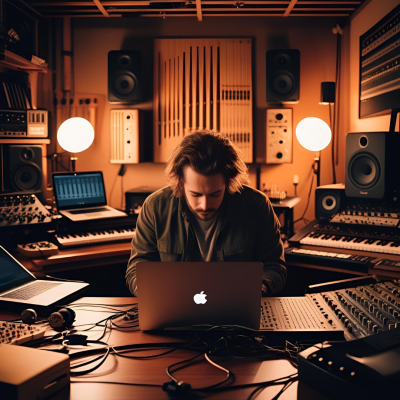Alternatives to Streaming: New Ways to Share Your Music
 Temps de lecture/Reading time : 4 minutes
Temps de lecture/Reading time : 4 minutes
In an era of thousands of streams for just a few cents, many independent artists are asking themselves: how can I share my music without getting lost in the noise or sacrificing my creativity?
Streaming is everywhere, but it’s not the only — nor the fairest — way to get your music heard. In this article, I’ll walk you through a few concrete alternatives I use, explore, or recommend.
Bandcamp: Sell your music and merch independently
Among the rare platforms that support a fair model for artists, Bandcamp stands out. It not only lets you stream your music but also sell it as digital downloads or physical formats (CDs, vinyl, cassettes) — without abusive intermediaries.
Why I use it:
- Fair revenue split: around 82% of earnings go directly to the artist.
- Flexible pricing options: pay-what-you-want, monthly subscriptions, bundles, etc.
- Integrated merchandising: t-shirts, posters, goodies — all in one place.
- Bandcamp Fridays: every first Friday of the month, Bandcamp takes no commission.
It’s a direct, ethical, and human way to share your music and build stronger bonds with your audience.
Live shows: Recreating a real experience
Nothing replaces the stage. Live performance remains one of the few spaces where you can truly connect with an audience, sell merch, and leave a lasting impression. It’s also a powerful way to promote new music.
Why live still matters:
- Direct source of income (ticket sales, performance fees, merch).
- Great opportunity to capture live recordings or videos for later release.
- Builds a more loyal and engaged fanbase.
That said, as I discussed [in this article], regular gigging comes with constraints: logistics, rehearsals, availability, physical and financial exhaustion… It’s a vital but demanding path — one I hope to explore more in the future.
Radio: Reaching different audiences
Radio — whether digital or traditional — remains a powerful broadcasting tool. There are two main approaches:
Webradios
Often run by passionate curators, these are more open to emerging artists. A well-crafted email is sometimes all it takes to get airplay.
Advantages:
- Accessible submission process
- Friendly, supportive curators
- Visibility within targeted music niches
FM Radio and large networks
These are harder to break into. In France, for example, you’d need to submit your tracks to Muzicenter, the database used by most FM radio programmers. The catch? Access is expensive — several hundred euros per release — and out of reach for many indie artists.
Personally, I’ve always submitted my tracks to as many webradios as possible, and some are still in rotation today. However, these airplays usually generate little to no royalties, unlike FM radio. If you want to maximize your chances, I recommend sending your press kits not only to music blogs, but also directly to radio stations. A single airplay can be as impactful as a written review.
Community and alternative platforms
While still niche, some platforms are worth exploring:
- SoundCloud: still relevant for genres like electronic or rap. Useful for testing ideas and getting direct feedback.
- Audius: blockchain-based platform with crypto payouts. Still young, but has potential.
- Resonate: a cooperative model where artists are co-owners. Listeners “pay per play,” offering fairer compensation.
Personally, I don’t currently use any of these. I find SoundCloud visually uninviting and dislike its interface, even if many musicians thrive on it. I also experimented with Audius but didn’t find much success — the crypto space still feels too murky and inaccessible to me.
Music Sync Licensing: Getting placed in video content
Sync licensing means placing your music in films, commercials, video games, or YouTube content. It’s a niche market, but a potentially lucrative one.
Platforms to explore:
- AudioSparx, Pond5, Songtradr, Artlist…
What to prepare:
- Well-organized metadata
- Instrumental versions of your tracks
- Quality visuals and a polished presentation
This is a professional path that requires patience and consistency but can generate valuable passive income. Personally, I’ve used AudioSparx for a few tracks, and one of them reached over 100,000 plays on Spotify — largely thanks to well-targeted playlist placements.
Newsletters & direct contact: Speaking to your audience without filters
Building a mailing list is perhaps the most underrated tool in music promotion. Never forget: an email address is often worth more than a “like.”
Why it’s powerful:
- No algorithms
- You can announce releases, concerts, videos… without filters
- Builds a loyal and sincere connection with your listeners
Tools like Mailchimp, Sendinblue, or open-source options like Buttondown or Substack can be great for managing your newsletter. I personally use Mailchimp — it’s simple and efficient. That said, it’s important not to overwhelm your subscribers. I limit myself to 4 or 5 emails per year, mostly around album releases.
Collectives and micro-labels: Pooling your strengths
Creating or joining a collective, non-profit label, or artist group is an excellent way to expand your reach:
- Shared production and promotion costs
- Organizing joint events or compilation albums
- Access to venues, media, or partners typically closed to solo artists
It’s also a way to rebuild human connections in an often fragmented ecosystem. A close musician friend (you know who you are) regularly encourages me to launch a structure like this. I find the idea compelling and keep it in mind for the future — though I haven’t taken the plunge just yet.
Streaming isn’t inevitable.
There are plenty of ways to share your music outside of the mainstream platforms — if you’re willing to step off the beaten path. From direct sales to live shows, radio airplay, sync licensing, collectives, and newsletters, every artist can carve out their own route: more human, more equitable, and often more rewarding.